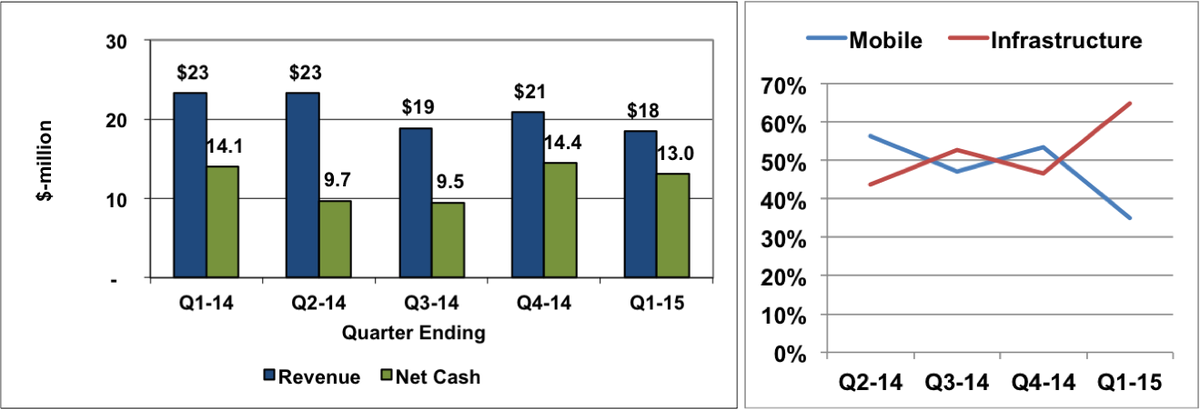More earnings calls last week, some product releases ahead of the International Microwave Symposium, and a few market snapshots worth reading:
Companies and Products
ANADIGICS Q1 revenue dropped 21 percent year-over-year to $18.4 million. In line with the company's strategy, infrastructure revenue grew 23 percent to 65 percent of the total. Their net cash declined $1.4 million to $13 million. Q2 revenue is expected to be down another 10 to 15 percent, due to delays in Wi-Fi and small-cell orders. ANADIGICS is implementing another round of layoffs to reduce costs and align manufacturing capacity with customer demand. The weak Q2 guidance led the stock price to drop 30 percent, once again below $1.

Freescale released two LDMOS power transistors for L-Band avionics applications, including a 250 W device with 31 dB gain and 64 percent drain efficiency.
Keysight has updated their SystemVue EDA software to include a 5G simulation reference library and allow direct integration of MATLAB script.
MACOM is beginning production of two modulator drivers for the 100G metro market. The designs support the coherent CFP2 standard. Also, MACOM released a 6 W power amplifier for the 27.5 to 30 GHz satcom band. The die PA has 23 percent power-added efficiency, -24 dBc IM3, and 24 dB gain.
Intending to spur collaboration on 5G research, National Instruments opened a Wireless Innovation Lab in Austin.
NXP released an LDMOS power transistor providing 140 W across the 2.6 to 2.7 GHz cellular band. The device has 30 percent drain efficiency and 17.4 dB gain. Download the data sheet.
Qorvo reported their first quarterly financial results as a merged company (RFMD + TriQuint). Revenue was $634.9 million, which was 46 percent above the year-ago period. Mobile segment revenue grew 61 percent to $493 million, and Infrastructure and Defense Products (IDP) was up 10 percent to $140 million.
Resonant, the pre-revenue start-up that is attempting to disrupt the mobile filter market, reported Q1 2015 expenses and updated the status of their new business efforts. They are pursuing three filter products with three customers.
Markets and Applications
The Navy is developing autonomous vehicles and robots to take soldiers out of harm's way. It's more challenging than teaching cars to drive on highways.
Is solid-state cooking the next big market for RF power transistors, dethroning the magnetron? NXP thinks so.
Cisco, Arris, and other equipment manufacturers are enabling the cable MSOs to better compete with FTTH, by boosting Internet access data rates.
Meanwhile, Google is slowly challenging broadband and wireless incumbents with new technology and business models.
Mobile apps are empowering independent truckers (some 250,000 drivers in the U.S.) to find new loads efficiently — similar to Uber.
Here's a humorous look at the current hyperbole surrounding the IoT. It's definitely a bubble set to burst, says Christopher Mims of The Wall Street Journal.
The New York Times remembers Joseph Lechleider, one of the fathers of DSL. "There was considerable skepticism. There were people who didn't want to deploy it. There were people who didn't think it would work. Many of them weren't sure there was a market for it." Yet it ultimately took hold, as it allowed the telcos to increase data speeds without replacing their copper networks.
What new technology are you skeptical of? Are you sure it won't work?

